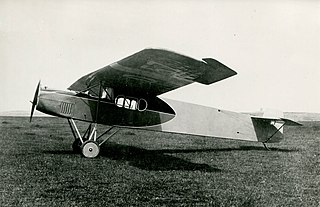
Hugo Junkers was a German aircraft engineer and aircraft designer who pioneered the design of all-metal airplanes and flying wings. His company, Junkers Flugzeug- und Motorenwerke AG, was one of the mainstays of the German aircraft industry in the years between World War I and World War II. His multi-engined, all-metal passenger- and freight planes helped establish airlines in Germany and around the world.

The Dornier Do J Wal ("whale") is a twin-engine German flying boat of the 1920s designed by Dornier Flugzeugwerke. The Do J was designated the Do 16 by the Reich Air Ministry (RLM) under its aircraft designation system of 1933.

The Junkers F 13 is the world's first all-metal transport aircraft, designed and produced by the German aircraft manufacturer Junkers.

Claude (Claudius) Honoré Désiré Dornier was a German-French airplane designer and founder of Dornier GmbH. His notable designs include the 12-engine Dornier Do X flying boat, for decades the world's largest and most powerful airplane. He also made several other successful aircraft.

The Siebel Si 204 was a small twin-engined transport and trainer aircraft developed in World War II. It was based on the Siebel Fh 104 Hallore. Originally designed in response to a German Ministry of Aviation development order for a small civil transport aircraft in 1938, it was eventually produced for the Luftwaffe.

Mannheim City Airport is a minor regional airport serving the German city of Mannheim. It is mainly used for general aviation.

DELAG, acronym for Deutsche Luftschiffahrts-Aktiengesellschaft, was the world's first airline to use an aircraft in revenue service. It operated a fleet of zeppelin rigid airships manufactured by the Luftschiffbau Zeppelin Corporation. Its headquarters were located in Frankfurt, Germany.

Deutsche Luft Hansa A.G. was a German airline. It served as flag carrier of the country during the later years of the Weimar Republic and throughout Nazi Germany, when it had close links to the Nazi Party.

The Junkers G 24 was a German three-engine, all-metal low-wing monoplane passenger aircraft manufactured by Junkers from 1925. Junkers F 24 was the designation for single-engine versions of the same aircraft.
Det Danske Luftfartselskab A/S or DDL, trading in English as Danish Air Lines, was Denmark's national airline from 1918 until it merged to create Scandinavian Airlines System (SAS) in 1951. DDL was established on 29 October 1918, but started its first scheduled route on 7 August 1920.

The Dornier Do R Superwal was a flying boat airliner designed and produced by the German aircraft manufacturer Dornier.

The Dornier Komet (Comet), Merkur (Mercury), Do C, Do D, and Do T were a family of aircraft designed and manufactured by the German aircraft manufacturer Dornier Flugzeugwerke.

The Fokker F.III was a single-engined high-winged monoplane aircraft produced in the 1920s by the Dutch aircraft manufacturer Fokker. It could carry five passengers. The aircraft was also built under licence in Germany as the Fokker-Grulich F.III.

The Fokker F.II was the first of a long series of commercial aircraft from the Fokker Aircraft Company, flying in 1919. In a biplane age, it presented a distinct clean, high-wing monoplane style that sold successfully across Europe and North America during the development of commercial passenger-carrying aviation.

Gressholmen Airport was a water aerodrome situated the island of Gressholmen in Oslo, Norway. It served as the main airport for Oslo from 1927 to 1939, along with Kjeller Airport. The aerodrome consisted of docks, a landing ramp, terminal building and a hangar and used a section of the Oslofjord as its runway. Being located on an island it was necessary to transport passengers by boat to the island. The airport only operated during the summer, typically from May through September.

The Junkers G 31 was an advanced tri-motor airliner designed and produced by the German aircraft manufacturer Junkers. It would be the first airliner operated by Deutsche Luft Hansa to feature a flight attendant.

The Sablatnig P.III was an airliner produced in Germany in the early 1920s.
Condor Syndikat was a German trade company, with headquarters in Berlin, that operated airline services in Brazil while also providing aircraft, maintenance and aviation information. It is also the parent company of the Brazilian airlines Varig and Syndicato Condor, which later became Serviços Aéreos Cruzeiro do Sul. They were the two oldest airlines in Brazil.

Ad Astra Aero was a Swiss airline based at Zürichhorn in Zürich.

Deutsche Zeppelin-Reederei, abbreviated DZR, is a German limited-liability company that operates commercial passenger zeppelin flights. The current incarnation of the DZR was founded in 2001 and is based in Friedrichshafen. It is a subsidiary of Zeppelin Luftschifftechnik and operates Zeppelin NT "Next Generation" airships. By 2009 the DZR had transported over 55,000 passengers. As of 2012 the DZR flies a schedule of 12 tour routes between March and November in Southern Germany. The company also operates flights to other selected cities as well as charter flights.



















